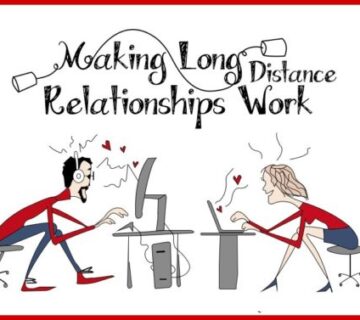Long distance relationship (LDRs) have become more common and, thanks to technology, more attainable than ever. But when your partner is hundreds or thousands of miles away, it’s natural to wonder—is this actually working? .
Table of Contents
-
Why Track the Health of Your LDR?
-
Top Signs Your Long Distance Relationship Is Working
-
Clear, Open, and Consistent Communication
-
Trust and Emotional Security
-
Shared Goals and a Future Plan
-
Emotional and Personal Growth
-
Prioritizing Each Other
-
Creativity in Staying Connected
-
Effective Conflict Resolution
-
Mutual Patience and Understanding
-
Celebrating Milestones and Visits
-
-
Science-Backed Indicators of LDR Success
-
Warning Signs of Trouble (What to Watch Out For)
-
Keeping Your LDR Strong: Actionable Tips
-
Conclusion: Sustaining Love Across Distance
1. Why Track the Health of Your LDR?
Being in a long distance relationship means you don’t get the daily affirmations or hugs that nearby couples do. That’s why noticing the right signs can reassure you both and help you proactively address potential pitfalls. Healthy LDRs don’t happen by accident—they’re built on intentional habits and mutual investment.
2. Top Signs Your Long Distance Relationship Is Working
Clear, Open, and Consistent Communication
-
You talk regularly and openly. Quality beats quantity, but some consistency—playful texts, long video calls, quick check-ins—shows you’re both investing time.
-
You feel heard and understood. There’s comfort in knowing your partner listens without judgment and responds thoughtfully.
-
You can talk about both the small details of your day and the big topics (goals, fears, excitement for the future).
Trust and Emotional Security
-
You trust each other deeply. You’re not constantly anxious about what the other person is doing. No snooping, tracking, or second-guessing.
-
You reassure one another when doubts creep in. When insecurities or jealousy pop up, you talk about them instead of letting them fester.
-
Faith in one another’s loyalty and intentions is mutual and consistent.
Shared Goals and a Future Plan
-
You both talk about your future together. Whether it’s planning the next visit, discussing a timeline to close the gap, or talking about moving, there’s a sense you’re moving toward a shared goal.
-
There’s always something to look forward to as a couple—reunions, shared vacations, or exciting milestones.
-
You both want the same things from the relationship and have aligned life visions.
Emotional and Personal Growth
-
Both partners are growing independently. You’re supportive of each other’s individual pursuits and proud of their achievements.
-
You handle the loneliness by developing yourself, not by seeking unhealthy distractions or emotional validation elsewhere.
-
You feel that the LDR is helping you both mature emotionally and become better partners, not just keeping you afloat between reunions.
Prioritizing Each Other
-
You both make room for each other, even in busy lives. This could be scheduling calls around time zones, checking in during important events, or just making sure you always say goodnight.
-
You don’t let work, family, or friends consistently come before the relationship.
-
When a visit, call, or “date night” is planned, you respect that commitment and avoid last-minute cancellations.
Creativity in Staying Connected
-
You find creative ways to bridge the distance. From virtual movie nights to sending small gifts or surprise letters to sharing playlists and games.
-
You use small rituals (e.g., lighting up special “friendship lamps” or sharing morning selfies) to maintain a sense of routine and closeness.
Effective Conflict Resolution
-
You talk through problems instead of avoiding them. Even across distance, you address tensions openly and seek to resolve differences as a team, not as adversaries.
-
Arguments lead to understanding, not resentment or the silent treatment.
-
You proactively check in about each other’s needs and are willing to adapt as the relationship evolves.
Mutual Patience and Understanding
-
You support each other when emotions are high. Bad moods, hard weeks, or stress are met with patience, not blame.
-
You’re both understanding about calendar mix-ups or time lapses—not quick to take offense or assume the worst.
Celebrating Milestones and Visits
-
Reunions are joyous, not awkward or stressful. Each visit brings you closer and recharges your bond.
-
You celebrate big moments (anniversaries, birthdays, career wins) together, even if virtually—forging shared memories that reinforce your partnership.
3. Science-Backed Indicators of LDR Success
Recent research reveals that long distance relationship success is tied to:
-
Trust and dependability: Strong trust correlates with higher satisfaction.
-
Emotional intimacy: Happy LDRs invest in ongoing emotional connection, not just logistics.
-
Communication: Successful couples prioritize quality conversations and resolve conflicts quickly.
-
Clear timelines: Couples who discuss and anticipate closing the distance (even years away) fare far better than those “drifting” indefinitely.
-
Mutual commitment: Both partners must genuinely want to make it work—not just one side chasing or accommodating all the time.
Healthy LDRs also report higher rates of meaningful emotional communication, shared goal-setting, and creative adaptation to the challenges posed by time zones or limited visits.
4. Warning Signs of Trouble (What to Watch Out For)
-
One partner always initiates; the other is apathetic or distant
-
No plans for future visits, or there’s a growing indifference about making them
-
Decreased communication, recurring misunderstandings, or avoidance of real issues
-
Jealousy, secrecy, or feeling unable to trust your partner
-
Lack of growth—either personal or mutual
-
Chronic loneliness, resentment, or a sense that you’re putting your life on pause.
5. Keeping Your LDR Strong: Actionable Tips
-
Always have a “next” milestone to look forward to—big or small.
-
Prioritize honest, judgment-free communication—even when it’s hard.
-
Find rituals and routines that uniquely fit your relationship.
-
Nurture trust: share daily lives, open up about struggles, and hold each other’s confidence.
-
Support growth for yourself and your partner—don’t let the relationship become your only emotional outlet.
-
Discuss when and how you’ll eventually close the distance—hope and a shared future are essential.
-
Cherish the positives: frequent heartfelt communication, creativity, and anticipation make LDRs uniquely special.
Read More: How to Avoid Scams on Dating Apps: The 2025 Human Guide
7. Conclusion: Sustaining Love Across Distance
Strong long distance relationships are built on trust, communication, shared vision, and the willingness to work through challenges as a team. The clearest signs your LDR is working are a deep sense of security, creative connection, mutual effort, personal growth, and unwavering anticipation for your next reunion. No matter the miles, love can flourish—if you’re both willing to nurture it.






[…] Read More: Signs Your Long Distance Relationship Is Working: The In-Depth 2025 Human Guide […]